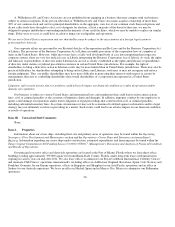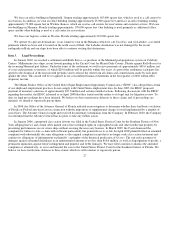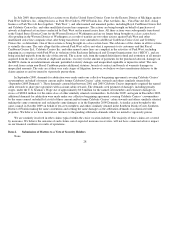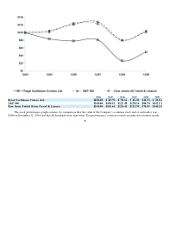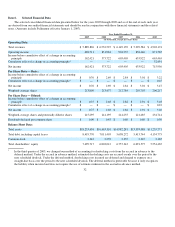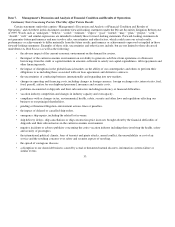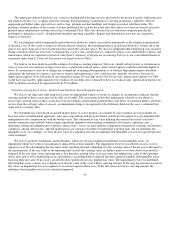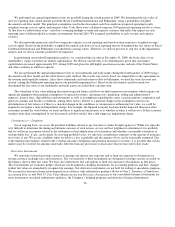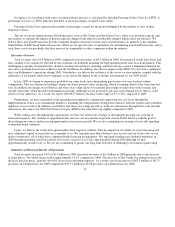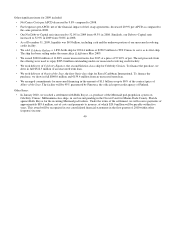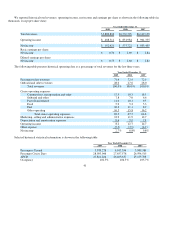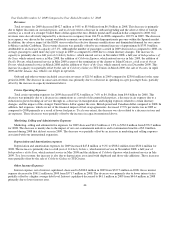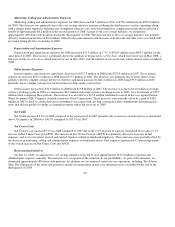Royal Caribbean Cruise Lines 2009 Annual Report Download - page 46
Download and view the complete annual report
Please find page 46 of the 2009 Royal Caribbean Cruise Lines annual report below. You can navigate through the pages in the report by either clicking on the pages listed below, or by using the keyword search tool below to find specific information within the annual report.
We performed our annual impairment review for goodwill during the fourth quarter of 2009. We determined the fair value of
our two reporting units which include goodwill, Royal Caribbean International and Pullmantur, using a probability-weighted
discounted cash flow model. The principal assumptions used in the discounted cash flow model are projected operating results,
weighted-average cost of capital, and terminal value. Cash flows were calculated using our 2010 projected operating results as a base.
To that base we added future years’ cash flows assuming multiple revenue and expense scenarios that reflect the impact on each
reporting unit of different global economic environments beyond 2010. We assigned a probability to each revenue and expense
scenario.
We discounted the projected cash flows using rates specific to each reporting unit based on their respective weighted-average
cost of capital. Based on the probability-weighted discounted cash flows of each reporting unit we determined the fair values of Royal
Caribbean International and Pullmantur exceeded their carrying values. Therefore, we did not proceed to step two of the impairment
analysis and we do not consider goodwill to be impaired.
In performing our goodwill impairment analysis, we considered the fact that at December 31, 2009, the book value of our
shareholders’ equity exceeded our market capitalization. We did not consider this to be determinative given that our market
capitalization increased approximately 85% during 2009 and given the still highly uncertain economic outlook of the United States
and other countries in which we operate.
We also performed the annual impairment review of our trademarks and trade names during the fourth quarter of 2009 using a
discounted cash flow model and the relief-from-royalty method. The royalty rate used is based on comparable royalty agreements in
the tourism and hospitality industry. Since these trademarks and trade names relate to Pullmantur, we used the same discount rate
used in valuing the Pullmantur reporting unit in our goodwill impairment test. Based on the discounted cash flow model we
determined the fair value of our trademarks and trade names exceeded their carrying value.
The estimation of fair value utilizing discounted expected future cash flows includes numerous uncertainties which require our
significant judgment when making assumptions of expected revenues, operating costs, marketing, selling and administrative
expenses, interest rates, ship additions and retirements as well as assumptions regarding the cruise vacation industry competition and
general economic and business conditions, among other factors. If there is a material change in the assumptions used in our
determination of fair values or if there is a material change in the conditions or circumstances influencing fair value, we could be
required to recognize a material impairment charge. For example, the Spanish economy has been harder impacted than most other
economies around the world where we trade and there is significant uncertainty as to whether or when it will recover. If that economy
weakens more than contemplated in our discounted cash flow model, that could trigger an impairment charge.
Contingencies — Litigation
On an ongoing basis, we assess the potential liabilities related to any lawsuits or claims brought against us. While it is typically
very difficult to determine the timing and ultimate outcome of such actions, we use our best judgment to determine if it is probable
that we will incur an expense related to the settlement or final adjudication of such matters and whether a reasonable estimation of
such probable loss, if any, can be made. In assessing probable losses, we take into consideration estimates of the amount of insurance
recoveries, if any. We accrue a liability when we believe a loss is probable and the amount of loss can be reasonably estimated. Due
to the inherent uncertainties related to the eventual outcome of litigation and potential insurance recoveries, it is possible that certain
matters may be resolved for amounts materially different from any provisions or disclosures that we have previously made.
Derivative Instruments
We enter into forward and swap contracts to manage our interest rate exposure and to limit our exposure to fluctuations in
foreign currency exchange rates and fuel prices. The vast majority of these instruments are designated as hedges and are recorded on
the balance sheet at their fair value. We have also entered into fuel call options to limit our exposure to fluctuations in fuel prices.
These instruments are economic hedges which are not designated as hedging instruments for accounting purposes and thus, changes
in their fair value are immediately recognized in earnings. Our derivative instruments are not held for trading or speculative purposes.
We account for derivative financial instruments in accordance with authoritative guidance. Refer to Note 2. Summary of Significant
A
ccounting Policies and Note 13. Fair Value Measurements and Derivative Instruments to our consolidated financial statements for
more information on related authoritative guidance, the Company’s hedging programs and derivative financial instruments.
36


